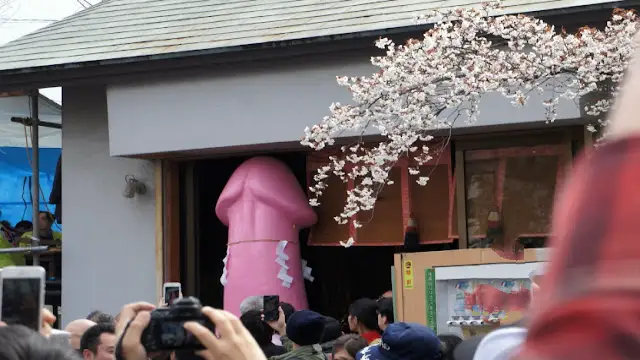KAWASAKI, JAPAN — Every spring, the streets of Kawasaki come alive with laughter and excitement during the Kanamara Matsuri, also known as the “Festival of the Steel Phallus.” This unique celebration honors fertility and the male anatomy in a way that is both humorous and educational.
A Colorful Celebration of Fertility
On a sunny Sunday in April, locals and visitors alike gather to witness the spectacle. Groups parade three enormous phalluses through the city, with the largest towering as tall as a grown man. The atmosphere is filled with joy as festival-goers, including children and grandparents dressed in traditional kimonos, indulge in penis-shaped lollipops and snap photos with phallic sculptures.
The festival is not just about fun; it serves an important purpose. According to Hiroyuki Nakamura, the local priest of the Kanayama Shrine, the event helps normalize discussions about male genitalia. “If young children are not used to seeing it, they could panic later,” he explained. The festival encourages open conversations about fertility and protection.
A Rich History
The origins of the Kanamara Matsuri date back to the Edo Period (1603-1868). Legend has it that a demon with sharp teeth lived in a woman’s vagina, causing chaos on wedding nights by castrating grooms. A local blacksmith crafted an iron dildo to defeat the demon, leading to the establishment of the shrine dedicated to fertility and protection from sexually transmitted infections.
Today, a one-meter black steel phallus stands proudly in the shrine’s courtyard, honoring the Shinto deities. Over the years, sex workers have also visited the shrine, seeking its blessings for safety and health.
Fun and Games
The festival features a variety of entertaining activities. One highlight is the radish-carving contest, where participants create anatomically correct radishes. This draws a crowd of giggling onlookers. Families can also enjoy a giant see-saw shaped like a phallus, where parents place their babies to pray for fertility.
Tens of thousands of people flock to the festival each year, eager to purchase quirky keepsakes. From keychains to chocolates, the market is filled with playful items that celebrate the theme of the festival.
A Serious Side
Despite the lighthearted nature of the event, there is a serious aspect to the Kanamara Matsuri. Proceeds from the sale of festival merchandise support HIV research. The shrine itself is a year-round destination for couples hoping to conceive, making it a place of hope and prayer.
Natsuki Kanayama, a nursery school teacher, expressed her enthusiasm for the festival. “It’s about propagating the species,” she said, holding lollipops in both hands. “I’m praying for as many children as possible.”
A Global Attraction
The Kanamara Matsuri has become a tourist attraction since the 1970s, drawing curious visitors from around the world. Jason Bradley, an American tourist, remarked, “It’s insane! I’ve heard about ‘Cool Japan’ — I guess this is what they mean.” The festival’s blend of humor, tradition, and community spirit captivates everyone who attends.
FAQs:
What is the Kanamara Matsuri?
The Kanamara Matsuri is a unique Japanese festival celebrating fertility and the male anatomy, held annually in Kawasaki.
When does the festival take place?
The festival typically occurs in early April each year.
What activities are featured at the festival?
Activities include parades with giant phalluses, a radish-carving contest, and various games for families.
Is the festival suitable for children?
Yes, the festival is family-friendly, with many activities designed for children and educational aspects about fertility.
What is the historical significance of the festival?
The festival has roots in Edo Period legends and serves as a place for prayer and protection against sexually transmitted infections.
How do proceeds from the festival help the community?
Proceeds from merchandise sales support HIV research and the shrine’s efforts to help couples conceive.
Conclusion
The Kanamara Matsuri is more than just a quirky festival; it’s a celebration of life, fertility, and community. It encourages open discussions about sexuality while providing a space for joy and laughter. If you ever find yourself in Japan during spring, don’t miss the chance to experience this one-of-a-kind event!
By embracing both the playful and serious elements of the Kanamara Matsuri, this festival continues to thrive as a vibrant part of Japanese culture.

